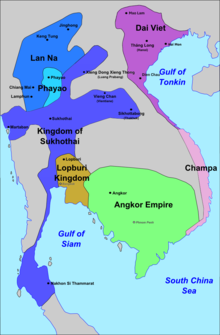Lý Chiêu Hoàng
| Lý Chiêu Hoàng 李昭皇 | |||||||||||||
|---|---|---|---|---|---|---|---|---|---|---|---|---|---|
Empress consort of Đại Việt | |||||||||||||
| Tenure | 1225–1237 | ||||||||||||
| Successor | Empress Thuận Thiên | ||||||||||||
| Born | September 1218 Thăng Long | ||||||||||||
| Died | 1278 (aged 60) Cổ Pháp, Đại Việt | ||||||||||||
| Burial | Thọ Tomb | ||||||||||||
| Spouse | Trần Thái Tông (1224–1237) Lê Phụ Trần (1258–1278) | ||||||||||||
| Issue | With Trần Thái Tông:
With Lê Phụ Trần:
| ||||||||||||
| |||||||||||||
| House | Lý (by birth) Trần (by marriage) | ||||||||||||
| Father | Lý Huệ Tông | ||||||||||||
| Mother | Trần Thị Dung | ||||||||||||
| Religion | Buddhism | ||||||||||||
| Posthumous name | |
| Vietnamese alphabet | Chiêu Hoàng đế |
|---|---|
| Chữ Hán | 昭皇帝 |
| Personal name | |
| Vietnamese alphabet | Lý Phật Kim |
|---|---|
| Chữ Hán | 李佛金 |

Lý Chiêu Hoàng (
Biography
Lý Phật Kim was born in September of
Having been mentally ill for a long time, the Emperor Lý Huệ Tông ultimately decided to cede the throne of the Lý dynasty to crown princess Lý Chiêu Hoàng in October of Lunar calendar, 1224.[5] Lý Chiêu Hoàng thus became the only empress regnant in history of Vietnam.[6][7][8][9][failed verification] This decision of Lý Huệ Tông was considered by the historian Ngô Sĩ Liên as the crucial factor leading to the collapse of the Lý dynasty, because if he had chosen a capable member of the royal family instead of his young princess, the situation for the dynasty could have been different.[5]
As empress regnant
Succeeding to the throne at the age of only six, Lý Chiêu Hoàng ruled under the total influence of Commander of Royal Guard
After the coronation of Trần Cảnh, now Trần Thái Tông, Lý Chiêu Hoàng was downgraded to Empress Consort Chiêu Thánh (Chiêu Thánh hoàng hậu) in January 1226.
As empress consort and princess
According to
In 1258, Thái Tông decided to remarry Princess Chiêu Thánh to the general Lê Phụ Trần because he had an essential role in the victory of Đại Việt over the first Mongol invasion. This event was one more time criticized in historical books for the lack of moral code in marriage during the Early Trần period.[23] Princess Chiêu Thánh died in Cổ Pháp[7] in March 1278 at the age of 61. With the second husband Lê Phụ Trần, she had two children, Marquis Lê Tông and Princess Ứng Thụy Lê Khuê.[24]
Legacy
Because of her role in the collapse of the Lý dynasty (as people acknowledged at that time), Lý Chiêu Hoàng was not worshipped along with her ancestors, and the eight previous emperors of the Lý dynasty, at the
Notes
References
Citations
- ^ Ngô Sĩ Liên 1993, p. 155
- ^ a b c d Ngô Sĩ Liên 1993, p. 157
- ^ Ngô Sĩ Liên 1993, p. 165
- ^ Trần Trọng Kim 1971, p. 47
- ^ a b Ngô Sĩ Liên 1993, p. 156
- ^ Thanh Trung (5 June 2009). "A young actor matures in his new role as a tragic king". Archived from the original on 14 September 2012. Retrieved 3 December 2009.
- ^ a b c d "Shrine's demise angers residents". Vietnamnet.vn. 14 April 2009. Archived from the original on 19 April 2009. Retrieved 3 December 2009.
- ^ a b "Historic relic demolished in the name of restoration". Vietnamnet.vn. 12 April 2009. Archived from the original on 3 January 2010. Retrieved 3 December 2009.
- ^ "Delays, studies force Ly to quit film role". Vietnamnews.vnagency.com. 24 July 2009. Retrieved 3 December 2009.
- ^ Ngô Sĩ Liên 1993, p. 154
- ^ a b Ngô Sĩ Liên 1993, p. 159
- ^ Ngô Sĩ Liên 1993, pp. 157–158
- ^ Chapuis 1995, p. 79
- ^ "Chuyển đổi ngày âm dương - Lunar calendar converter". Retrieved 22 March 2021. The second option on the left tab allows for the lunar date to be entered on the top green row, and gives a conversion to Gregorian date, and vice versa.
- ^ Ngô Sĩ Liên 1993, pp. 158–159
- ^ Ngô Sĩ Liên 1993, p. 160
- ^ National Bureau for Historical Record 1998, p. 194
- ^ Chapuis 1995, p. 80
- ^ Ngô Sĩ Liên 1993, p. 163
- ^ Trần Trọng Kim 1971, p. 49
- ^ Ngô Sĩ Liên 1993, pp. 164–166
- ^ National Bureau for Historical Record 1998, pp. 195–196
- ^ Ngô Sĩ Liên 1993, p. 174
- ^ Ngô Sĩ Liên 1993, p. 185
- ISBN 2-7483-2450-1.
Sources
- Ngô Sĩ Liên (1993), Đại Việt sử ký toàn thư (in Vietnamese) (Nội các quan bản ed.), Hanoi: Social Science Publishing House
- National Bureau for Historical Record (1998), Khâm định Việt sử Thông giám cương mục (in Vietnamese), Hanoi: Education Publishing House
- Saigon: Center for School Materials
- Chapuis, Oscar (1995), A history of Vietnam: from Hong Bang to Tu Duc, Greenwood Publishing Group, ISBN 0-313-29622-7
| |||||||
Notes:
| |||||||
